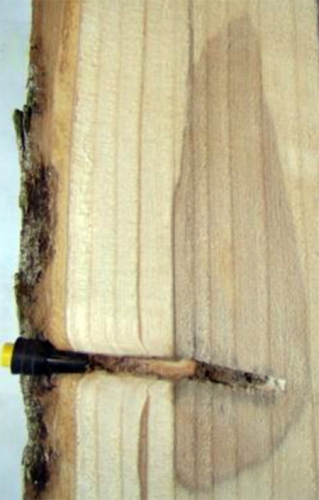Trunk injections are changing the tree care industry
Invasive species like the emerald ash borer have driven research for better use of trunk injections.
When I was growing-up I remember two innovations said to be spin-offs from NASA space research: a powdered orange juice substitute (Tang) and cookware you can take from the refrigerator and put in the oven (Corning Ware). Now we are enjoying some new tree care options generated from research on emerald ash borer.
The most important advancement for the tree care industry is the improvement of trunk injection methods in general, and specifically, two to three years of protection against borers following a single treatment. Trunk implants or trunk injection treatments have been used by a small but growing segment of the tree care industry since the 1970’s when Neely (1973) restored the color of iron-deficient pin oaks, and Kielbaso and Ottman (1976) successfully treated manganese-deficient red maples with trunk implant treatments.
Several other types of trunk injection treatments became popular over the last 30 years, including bidrin for bronze birch borer, and several fungicides for Dutch elm disease. Still, two problems prevented a broader adoption of trunk injections by the tree care industry: (1) most of the treatments required an annual application, making it cost-prohibitive for most customers, and (2) arborists were concerned about the wounding caused by drilling holes in tree trunks for the injection treatments.
Extensive research on emerald ash borer has eliminated both of these problems. First, research by Smitley et al. (2010) indicates that most ash trees will be completely protected from emerald ash borer for two to three years following a trunk injection treatment with emamectin benzoate. This means that trees could be treated once every three to four years, and after the initial wave of emerald ash borer has passed – killing nearly all of the unprotected ash trees in the area– it may be possible to space treatments even further apart. Some cities like Chicago are now trunk-injecting ash street trees because even over a 20 to 30-year period it does not cost any more than removing the trees.
The second issue, wounds made by trunk injection equipment, has also been found to be unimportant for healthy trees, at least for ash trees. In a study where ash trees were trunk injected, then felled, sectioned and examined two to five years later, all of the wounds to healthy trees healed rapidly, closing completely in two years with no signs of infection, rot or structural damage (Doccola et al. 2011). Only wounds on seriously weakened trees did not heal rapidly. Perhaps this is why trunk injections were believed to cause unacceptable wounding: if the treatment did not cure a sick tree, it continued to decline and the wounds did not heal properly. However, the paper by Doccola and coleagues clearly shows that healthy ash trees rapidly close trunk injection wounds without any adverse effects (Photo 1). Now that a trunk injection treatment has been shown to provide a high level of protection against borers for two to three years at a reasonable cost, and without injuring trees, I expect this to become a standard treatment for any valuable trees susceptible to borers, and in the future, for many other pests as well.

Photo 1. Sectioned bolt of ash tree trunk four years aftertrunk injection. Although some discoloration is obvious, there is no infection, rot or structural damage.
References
Smitley, D.R., Doccola, J.J. and D.L. Cox. 2010. Multiple-year protection of ash trees from emerald ash borer with a single trunk injection of emamectin benzoate and single-year protection with an imidacloprid basal drench. Arboriculture & Urban Forestry 36: 206 - 211.
Doccola, J.J., Smitley, D.R., Davis, T.W., Aiken, J.J. and P.M. Wild. 2011. Tree wound response following systemic insecticide trunk injection treatments in green ash (Fraxinus pennsylvanica Marsh.) 2011. Arboriculture & Urban Forestry 37: 6–12.
Kielbaso, J.J. and K. Ottman. 1976. Manganese deficiency- contributory to maple decline? Journal of Arboriculture (Feb) 27 – 32.
Neely, Dan. 1973. Pin oak chlorosis- trunk implantations correct iron deficiency. Journal of Forestry 71: 340 – 342.



 Print
Print Email
Email

